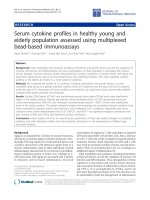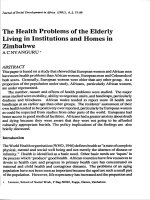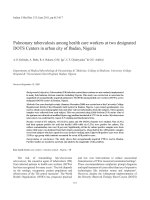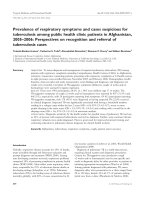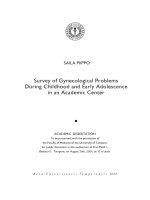Perceived Gynecological Morbidity among Young ever-married Women living in squatter settlements of Karachi, Pakistan doc
Bạn đang xem bản rút gọn của tài liệu. Xem và tải ngay bản đầy đủ của tài liệu tại đây (259.98 KB, 8 trang )
Perceived Gynecological Morbidity among Young ever-married
Women living in squatter settlements of Karachi, Pakistan
Pages with reference to book, From 92 To 97
Fatima Sajan,Fariyal F. Fikree ( Department of Community Health Sciences, The Aga Khan University, Karachi,
Pakistan. )
Abstract
Background: Community-based information on obstetric and gynecological morbidity in developing
countries is meager and nearly non-existent in Pakistan.
Objectives: To estimate the prevalence of specific gynecological morbidities and investigate the
predictors of pelvic inflammatory disease
Methods: Users and non-users of modem contraceptives were identified from eight squatter
settlements of Karachi, Pakistan and detailed information on basic demographics, contraceptive use,
female mobility, decision-making and gynecological morbidities were elicited.
Results: The perceived prevalence of menstrual disorders were 45.3%, uterine prolapse 19.1%, pelvic
inflammatory disease 12.8% and urinary tract infection 5.4%. The magnitude of gynecological
morbidity was high with about 55% of women reporting at least one gynecological morbidity though
fewer reported at least two gynecological morbidities. Significant predictors of pelvic inflammatory
disease were intrauterine contraceptive device users (OR = 3.1; 95% CI 1.7- 5.6), age <20 years (OR =
2.3; 95% CI 1.1 - 4.8) and urban life style (OR = 2.1; 95% CI 1.0-4.6).
Conclusion: There is an immense burden of reproductive ill-health and a significant association
between eyer users of intrauterine contraceptive device and pelvic inflammatory disease. We therefore
suggest improvement in the quality of reproductive health services generally, but specifically for family
planning services (JPMA 49:92, 1999).
Introduction
Gynecological morbidity has been defined as structural and functional disorders of the genital tract
which are not directly related to pregnancy, delivery and puerperium. It includes menstrual disorders,
reproductive tract infections, cervical cell changes, genital prolapse and other related morbidities such
as syphilis, urinary tract infections (UTI) and anemia
1
.
A study on the prevalence of gynecological morbidity in Pakistani women reported that nearly 17% had
cervical infections, erosions or ulceration and 10.9% had utero-vaginal prolapse
2
. Another study from
Lahore, reported a high prevalence of gynecological morbidities: 77.1% vaginal discharge, 3.0% pelvic
inflammatory disease (PID) and 38.6% UT!, while in another study 82% of the 434 non-pregnant clinic
attendees reported menstrual problems
3
.
An analysis of self-reported symptoms of gynecological problems in Kamataka, India among 3,600
women, reported that one-third of all women mentioned at least one current symptom:
the most common being a feeling of weakness and tiredness, menstrual disorders, white or colored
vaginal discharge, lower abdominal pain and discharge with fever
4
. Other community-based studies in
India report menstrual disorders such as heavy, light, irregular; painful menstruation or spotting as the
major gynecological complaint
5
, ranging from a low of 33% in rural West Bengal to 60% or more in
rural Maharashtra and Kamataka.
Prevalence of other gynecological morbidities such as UTI - 4%J and uterine prolapse - 8%
1
have been
reported from community-based studies conducted in India and Egypt
4,6
. Much higher prevalences,
around 20%, have been reported for PID among rural women in Kenya, Uganda, and India
7
. Several
studies among rural Indian women report the prevalence of white or colored vaginal discharge and
malodorous vaginal discharge or itching/irritation and fever ranging from 16% to In several African
countries, 22% to 44% of hospital admissions in gynecological wards were due to PID
10
, while, in a
New Delhi hospital, India, over a five-year period, only 2.8% of cases were admitted with pelvic
infections
11
.
The major risk factors for PID in developing countries were behavioral or socioeconomic. For example,
reports from South India, show that women were more likely to report menstrual disorders,
dyspareunia, prolapse, ND and UTI had poor behavioral factors like poor personal hygiene, or
unsanitary household conditions, or low exposure to health information4. However, low socio-
economic’ status and poor education are also well-recognized major risk factors for PID
Intrauterine contraceptive device frequent urination and burning urine in the preceding three months.
For the in-depth analysis of predictors of PID, we classified our cases as those women who reported
currently suffering from foul-smelling vaginal discharge accompanied by fever and/or lower abdominal
pain (n = 92). Our controls were women who did not report any of these symptoms (n 625).
Potential Risk Factors
The risk factors under investigation were broadly classified as socioeconomic and demographic
variables including women’s education, occupation, urban residence, household assets, age of the
women, age at marriage and duration of marriage. In addition, parity and current user status by type of
method used were also investigated.
A composite index was computed for socioeconomic status based on ownership of twelve household
assets ownership of such items as iron, sewing machine, refrigerator, washing machine, motor cycle,
car etc. In this paper, “household assets” will be considered as a proxy indicator for socioeconomic
status. The classification of low, average and high socioeconomic status was based on cut-off values
representing approximately two standard deviations below the mean. Thus, women who reported
owning up to four items were considered as belonging to the low socioeconomic strata; those reporting
owning five to nine items were considered as belonging to the average socioeconomic strata while
those owning 10 or more items were considered as belonging to the upper socioeconomic strata.
Current use of family planning method included women who were currently using or have used any
modem method of contraception in the past twelve months. Modern contraceptive methods included
hormonal, IUCD, condom and tubal ligation. Prior IUCD users may be currently suffering from PID (a
chronic infection) though currently using other modern methods of contraception. We therefore
included the 37 women who previously reported using IUCDs as “IUCD users”, irrespective of their
reported PID status.
Statistical analysis
First, prevalence of various gynecological morbidites such as menstrual disorders, uterine prolapse,
PID and UT! were computed. Then, univariate and multivariable logistic regression analyses was
conducted for identifying the risk factors for PID. The bivariate associations between socioeconomic
and demographic variables and other variables with cases and controls were investigated, and odds
ratios and p-values were calculated.
Due to multi-collinearity and possible confounding among some of the risk factors identified in the
bivariate analyses, multiple logistic regression were run to assess the effect of each risk factor in the
presence of other variables in the model.
The criteria for including variables in the multiple logistic regression analyses was a p-value of <0.1
upon bivariate associations. The potential risk factors which met our selection criteria were entered in
the logistic regression model and significance of the regression coefficients were noted. Those risk
factors which had a p-value of<0.I were identified for inclusion in the subsequent model, priority of
addition was based on the magnitude of their p-vaJues. The final overall regression models only
include risk factors with a p-value of <0.05. Data analyses were performed on Epilnfo version 6.04b
and SPSS version 7.5 for windows
18,19
.
Results
Menstrual disorders were the major gynecological morbidity with nearly 45% of women reporting
either heavy bleeding, prolonged bleeding or painful menses. Even though the sample population were
young women years], the reported prevalence of uterine prolapse was nearly 19%. However, lower
prevalences were reported for PID and UTI (Table 1).
The magnitude of gynecological morbidity was high with about 55% of the women reporting at least
one gynecological morbidity, the most common being menstrual disorders. However, the proportion of
women reporting at least two gynecological morbidities was much lower with menstrual disorders and
uterine prolapse being the most frequent.
The unadjusted odds ratios and 95% confidence intervals for the risk factors for PID are shown in Table
2.
Although life style (categorized as urban if a woman had lived in a city for >12 years else it was
considered as rural exposure) was significantly associated with reported PID, other socioeconomic and
demographic characteristics such as educational status, occupation and household assets were not
significantly associated with reported PID. Women who reported PID were almost two and a half times
more likely to have an urban exposure as compared to women who did not report suffering from PID.
Age and current use of family planning method were significantly associated with reported PID.
Women who reported suffering from PID were twice as likely to be <20 years of age as compared to
those women not suffering from PID. PID sufferers were three times more likely to report using IUCDs
as compared to non-sufferers of PID. Age at marriage, duration of marriage and parity were not
significantly associated with reported PID.
Table 3 shows the adjusted odds ratios for the multivariate logistic regression models. Life style,
current age and use of modern methods of contraceptives which were significant in the unadjusted
analysis retained their significance in the final model with minimal change in the magnitude of their
odds ratios.
Discussion
The magnitude of gynecological morbidity, as reported by the young women in our sample,
underscores the burden of ill-health among young women living in urban squatter settlements of
Karachi, Pakistan. Approximately 55% of the women in this study reported having at least one
gynecological morbidity, similar to studies reported from India
5
where the magnitude of gynecological
morbidities ranged from 33% to as high as 92%
4,5,20
.
There was a marked difference in the prevalence of women reporting at least one and at least two
gynecological morbidities : menstrual disorders and uterine prolapse being the most frequently reported
morbidities. This decline in the magnitude of ill-health, though significant, is still unacceptably high as
uterine prolapse largely contributes to the 20% of women who complain of at least two gynecological
morbidities. The chronic sequelae of uterine prolapse is urinary incontinence and requires surgical
intervention. Thus, if nearly 20% of these women are now complaining of symptoms of uterine
prolapse, the medical costs of surgical repair needs to be considered in any health planning for these
communities.
Our prevalence of nearly 45% for reported menstrual disorders lie in-between the prevalence reported
from rural West Bengal , rural Maharashtra and Karnataka {60%]
2
. We feel, however, that our results
may overestimate the “true” prevalence of menstrual disorders as neither did we conduct a detailed
medical history nor did our interviewers have a medical background which would have enabled them to
more effectively probe into the perceived signs and symptoms of these gynecological morbidities. On
the other hand, prevalences reported from the Lahore clinicbased study
3
are much higher than our
study results, reflecting, we feel, a sampling bias - clinic population for the Lahore study
3
and
community-based for our. study.
PID was reported by nearly 13% of the women interviewd. On the other hand higher prevalences
[around 20%] have been reported among rulal woman in Kenya, Uganda, and India
7
. A possible
explanation for high prevalences of PID could be the high rate of sexually transmitted diseases TDs] in
these countries as compared to our population. For example, results of a survey conducted among
women in an urban, low income community in Karachi, report 0.2% prevalence of Treponema
pallidium, 0.9% of Neisseria gonorrhoea, 0.2% of Chiamydia trachomatis and 4.7% of Trichomonas
vaginalis. The overall prevalence of STDs was less than 5% for any of the four pathogens mentioned
Ever use of IUCD has been shown in our study and in other studies
5,6,12,14,20
to be a major predictor of
PID. The most likely route for transmission of infections culminating in PID is either through a
mismatch in the size of IUCD or infection spreading through the IUCD thread
6,21
. We therefore
suggest that insertion of IUCD be conducted under aseptic conditions.
Age 20 years is a significant predictor of PID as reported from our study as well from other studies
conducted in developed countries like Netherlands, Sweden and USA which report PID to be more
common among younger, unmarried women
15
. Moreover, early, pre or extra-marital sex has been
shown to significantly influence the development of STDs and P1D
22-25
. Though young age is
associated with high-risk behavior as well as low prevalence of protective immunoglobulins against
STDs and organisms causing bacterial vaginosis
26
, to establish whether young age is to be regarded as
a risk marker or a risk modifier or both with regard to STD acquisition and subsequent PID appears
difficult to determine with our current knowledge.
In conservative societies like Pakistan, marriage is an indication of active sexual life and young age at
marriage can possibly result in injury of the thin and fragile vaginal epithelium due to initiation of
sexual intercourse at ages younger than fifteen. We therefore suggest that women should get married at
older ages as our results show that PID sufferers were 2.3 times more likely to be younger married
women as compared to non-sufferers of PID (Table 3). It is extremely encouraging to note that the
trend of increasing age at marriage in Pakistan has risen by nearly two years -from 20.2 years in 1981
to 22 years in 1994/95 and we hope that this will rise even further in the future.
An interesting characteristic among our study population is that PID sufferers were more likely to be
women who had been exposed to urban life. The possible explanations could be either better reporting
as these women are also more likely to have received some education or that overcrowding in urban
settings leads to unsanitary conditions and consequently higher probability of infections. However, our
study did not probe into this factor but we suggest that future studies need to examine this
phenomenon.
In summary, we report an immense burden of reproductive ill-health among young Muslim women
living in squatter settlements of Karachi, Pakistan. Furthermore, the strong and consistent association
between ever users of IUCDs and PID strengthens the call for improving quality of reproductive health
services generally, but specifically for family planning services.
Acknowledgment
This investigation received financial support from the UNDP/UNFPA/WHO/World Bank, Special
Programme of Research, Development and Research Training in Human Reproduction, World Health
Organization through research grant Project Number 94128 BSDA.
References
1. Bhatia, J.C., Cleland, J., Bhagavan, L., et at. Levels and determinants of gynecological morbidity in
a district of South India. Stud Fam Plann. 1997; 28, 2: 95-103.
2. Khan, T. Family formation and maternal health: Pakistan. In: Omran AR, Standley CC, ed. Family
formation patterns and health further studies: an international collaborative study in Colombia, Egypt,
Pakistan, and the Syrian Arab Republic. Geneva, World Health Organization, 1981; 287-95.
3. Maternity and Child Welfare Association of Pakistan. Reproductive morbidity in an urban
community of Lahore. Zafarsons Printers, Lahore, Report. 1992-93; pp 29, 40.
4. Bhatia, J.C. and Cleland, J. Self-reported symptoms of gynecological morbidity and their treatment
in South India. Stud Fain. Plann., 1995; 26, 4: 203-216.
5. Patel, P. Illness beliefs and health-seeking behavior of the Bhil women of Panchamahal District,
Gujarat State. In: Gittelsohn, J., Bentley, M.E., Pelto, P.J., et al, eds. Listening to women talk about
their health. Issues and evidence from India Gujrat, 1994; 55-66.
6. Younis, N., Khattab, H., Zurayk, U., ct at. A community study of gynecological and related
morbidities in Rural Egypt. Stud in Fam. Planu., 1993; 24 (3), 175-86.
7. Dixon-Mueller R, Wasserheit J. The culture of science: reproductive tract infections among women
in the third world, IWHC., 1991; 1-20.
8. Bang RA, Bang AT, Why women hide them: rural women’s viewpoints on reproductive tract
infections. Manushi-a journal about women and society. 1992; 69: 27-30.
9. Bang RA, Bang AT. Women’s perceptions of white vaginal discharge: ethnographic data from rural
Maharashtra. En: Gittelsohn, J., Bentley, ME., Pelto, P.J., et at, eds. Listening to women talk about their
health. Issues and evidence from India,. 1994; pp. 79-94.
10. Ratnam AV, Din SN, Chaterjee 1K. Gonococcal infection in women with pelvic inflammatory
disease in Lusaka, Zambia. Am J Qbstet GynecoL, 1980; 138: 965-68.
11. Kochar M. Etiology of pelvic infections treated by the gynecologic service of the Kasturba hospital,
Delhi, India. Am 3 Obstet Gyuecol., 1980; 138: 872-874.
12. Meirik 0. Infection in non-pregnant women: incidence aiid risk factors in the 1980s and I 990s.
Proceedings from the fourth international conference on IUDs., 1994; 142-50.
13. Ory HW. A review of the association between intrauterine devices and acute pelvic inflammatory
disease. J. Reprod. Med., 1978; 20: 200.
14. Wolner-Hanssen P, Eschenbach DA, Paavonen J, et al. Decreased risk of symtornatic chlamydial
pelvic Inflammatory disease associated with oral contraceptive use. JAMA., 1990; 263 (1), 54-59.
15. Wasserheit,.JN. The significance and scope of reproductive tract infections among the third world
women. int J Gynecol Obstet. 1989; (Supplement 3), 145-68.
16. Chnstopher E. Sexually transmitted diseases and the reproductive health of women in developing
countries. RH Training Materials; Programs Division Working Paper No.5. New York, Population
Council, Programs Division, 1991. VII,p 54.
17. Brabin,.L. Pelvic inflammatory disease. Afri Health. 1993; 3: 15-17.
18. Epi Info 6. A word processing, database and statistics program for public health. Version 6.04b.
CDC, USA and WHO, Geneva, Switzerland, 1997.
19. SPSS Inc. Version 7.5 for Windows. 1996.
20. Bang AT., Bang RA., Baitule M, et at. High prevalence of gynecological morbidity in rural Indian
women. The Lancet. 1989; 1: 85-88.
21. Amsel R, Totten PA, Spiegel CA, et al. Non-specific vaginitis: diagnostic criteria and microbial and
epidemiologic association, Am J Med., 1983; 74,1:14-22.
22. Grech ES, Everett JV, Mukasa F. Epidemiologic aspects of acute inflammatory disease. Tropical
doctor 1973; 101: 123-27.
23. O’Farrell N, Hoosin AA, Kharsany ABM, ct aI. Sexually transmitted pathogens in pregnant women
in rural South African community. Genitourina Med, 1989; 65: 276-80.
24. Cates W, Roles RT, Aral SO. Sexually transmitted disease, pelvic inflammatory disease and
infertility: an epidemiologic update. Epiderniol Revi, 1990; 12; 199-220.
25. Onibuloye LO, CaIdwell JC, Caldwell P. Sexual networking in the Ekiti District of Nigeria. Stud.
Fain. Plan., 1991; 22: 61-73.
26. Population Council, Ministry of Population Welfare and Uiaited Nations Population Fund. Pakistan
contraceptive prevalence survey. Final Report. 1994;95; pp. 57.



